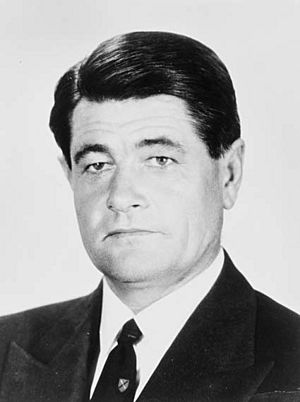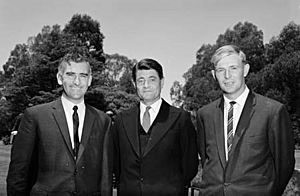Jim Forbes (Australian politician) facts for kids
Quick facts for kids
Dr Jim Forbes
|
|
|---|---|
 |
|
| Minister for Immigration | |
| In office 22 March 1971 – 5 December 1972 |
|
| Prime Minister | William McMahon |
| Preceded by | Phillip Lynch |
| Succeeded by | Lance Barnard |
| Minister for Health | |
| In office 26 January 1966 – 22 March 1971 |
|
| Prime Minister | Harold Holt John McEwen John Gorton William McMahon |
| Preceded by | Reginald Swartz |
| Succeeded by | Ivor Greenwood |
| Minister for the Army | |
| In office 18 December 1963 – 26 January 1966 |
|
| Prime Minister | Robert Menzies |
| Preceded by | John Cramer |
| Succeeded by | Malcolm Fraser |
| Minister for the Navy | |
| In office 18 December 1963 – 4 March 1964 |
|
| Prime Minister | Robert Menzies |
| Preceded by | John Gorton |
| Succeeded by | Fred Chaney |
| President of the Liberal Party of Australia | |
| In office 15 May 1982 – 16 July 1985 |
|
| Leader | Malcolm Fraser Andrew Peacock |
| Preceded by | Sir John Atwill |
| Succeeded by | John Valder |
| President of the South Australian Liberal Party |
|
| In office 13 November 1979 – 1982 |
|
| Leader | Dr. David Tonkin |
| Preceded by | John Olsen |
| Succeeded by | Don Laidlaw |
| Member of the Australian Parliament for Barker |
|
| In office 13 October 1956 – 11 November 1975 |
|
| Preceded by | Archie Cameron |
| Succeeded by | James Porter |
| Personal details | |
| Born |
Alexander James de Burgh Forbes
16 December 1923 Hobart, Tasmania, Australia |
| Died | 10 August 2019 (aged 95) Adelaide, South Australia, Australia |
| Political party | Liberal |
| Spouse |
Margaret Blackburn
(m. 1952) |
| Relations | Arthur Blackburn (father-in-law) |
| Alma mater | Royal Military College, Duntroon University of Adelaide Magdalen College, Oxford |
| Military service | |
| Allegiance | Australia |
| Branch/service | Australian Army |
| Years of service | 1940–1947 |
| Rank | Lieutenant |
| Unit | 2nd Australian Mountain Battery |
| Battles/wars | Second World War |
| Awards | Military Cross |
Alexander James de Burgh Forbes (16 December 1923 – 10 August 2019), also known as A. J. Forbes, was an important Australian politician. He was a member of the House of Representatives from 1956 to 1975. He belonged to the Liberal Party.
Dr. Forbes held several key government jobs, including Minister for the Navy, Army, Health, and Immigration. He was known for his work in the military and his dedication to public service.
Contents
Early Life and Military Service
Jim Forbes was born in Hobart, Tasmania, on 16 December 1923. He went to school in Sydney and Adelaide. After finishing school, he joined the Royal Military College, Duntroon in 1942. He then became an officer in the Australian Army.
He served in World War II and was stationed in Darwin in 1943. Later, he joined the 2nd Mountain Battery. In 1945, he received the Military Cross (MC) for his bravery during the war. His father and brother also received this award for their courage in other wars.
After the war, Jim Forbes left the army in 1947. He went to the University of Adelaide and earned a degree. He then studied political science at Magdalen College, Oxford in England. He earned a PhD in 1954. His studies focused on how countries like Australia worked together for safety and well-being.
When he returned to Australia, he taught political science at the University of Adelaide. In 1952, he married Margaret Blackburn. They had five children together.
Political Career
Starting in Politics
Jim Forbes was interested in politics from a young age. He led a student political group at Adelaide University. In 1955, he first tried to become a member of parliament but didn't win.
However, in 1956, he won a special election for the seat of Barker in South Australia. He kept this seat until he retired from politics in 1975. In parliament, he was part of a group of Liberal politicians who had studied at Oxford or Cambridge universities.
Serving as a Minister
After the 1963 election, Jim Forbes became a minister in the government. He was first appointed Minister for the Army. He also briefly served as Minister for the Navy.
As Army Minister, he helped create a system for young men to join the army for a period of time. This was called the National Service Act 1964. It was a way to make sure the army had enough soldiers. He believed it was a fair system, even if it wasn't always popular.
In 1966, he became Minister for Health. During this time, he made some big decisions. He decided to sell a government-owned meat processing plant. He also banned certain types of imported cheese to protect public health.
Later, he helped set up a national health plan. This plan made sure that people with lower incomes could get free health insurance. It also allowed people to keep private health insurance if they wanted.
In 1971, Jim Forbes became Minister for Immigration. He held this role until the government lost the election in 1972.
Last Years in Parliament
Towards the end of his time in parliament, there were some disagreements. In 1973, he had a public argument with the Prime Minister, Gough Whitlam. The argument was about a comment made during a parliamentary session.
In 1975, the leader of his party, Billy Snedden, was replaced by Malcolm Fraser. Jim Forbes decided to leave his frontbench role and retire from parliament. He felt disappointed by the disagreements within his own party.
After Politics
After leaving parliament, Jim Forbes continued to be involved in public life. He was the chairman of the Commonwealth Serum Laboratories from 1978 to 1984. This organization makes important medicines and vaccines.
He also served on the council of the National Library of Australia. From 1982 to 1985, he was its chairman. He stayed active in politics, becoming the state president of the Liberal Party in South Australia in 1979. In 1982, he became the federal president of the Liberal Party. He left this role in 1985, urging his party to work together.
Jim Forbes passed away on 10 August 2019, in Adelaide, at the age of 95.
Awards and Honours
Jim Forbes received several awards for his service.
- In 1977, he was made a Companion of the Order of St Michael and St George. This was to recognize his service to the parliament.
- In 2001, he was awarded the Centenary Medal. This was for his work in the Australian Parliament and as chairman of the Commonwealth Serum Laboratories.


